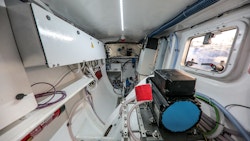Energy Observer propulsion

One of the advantages of the Energy Observer’s electric motors is that they are reversible: they can generate a complement of electricity up to twice 4 kW, which will finally be put to use in 2019.
Analysis of the speed/power curve demonstrates that the optimal speed for the Energy Observer is 4.5 knots, which was the boat’s average speed in 2018. Above this speed, the power consumed is exponential. Several peaks of up to 12.7 knots were recorded, however, to escape bad weather, or to gain lost time.
But each hull has its own nominal velocity characteristics, and depending on the weather, an optimal velocity output. Not to mention the crew – most of whom have a racing background – who intend to improve the performance!
Another significant advantage of electric motors is their silence. Obviously for the crew’s quality of life when berthed: the noise and odours from neighbouring boats’ generators can be unbearable. What’s more, this factor is often neglected when considering the effects on the submarine ecosystem.
In Greece, the Energy Observer crew met with acoustic engineers from the Archipelago association who scanned the submarine noise frequencies of the boat’s motors.

Victorien Erussard listens to the sounds
The result
Less than 1 kHz, which is much less than the 3 kHz considered by scientists to be the tolerance threshold for disturbing wildlife and large mammals. And much less than the thousands of diesel motors that cross the Aegean Sea.